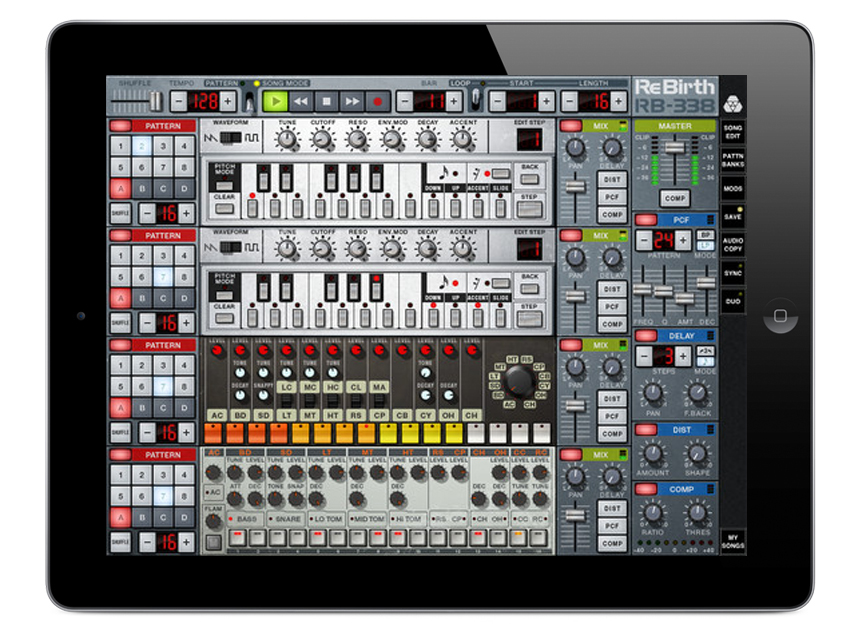"This might not be such a good idea after all": A YouTuber tries to recreate classic $200 ReBirth software with $15,000 worth of original vintage Roland hardware
Yes, he really is using using vintage hardware to emulate software that emulated the vintage hardware.

A YouTuber has used at least $£15,000 worth of Roland vintage synths and drum machines to emulate a piece of software that used to recreate all that hardware for $£200. Is he crazy, or does he simply have too much time on his hands? Actually, there is a good 'reason' for the exercise, but let's hope it's not the (re)'birth' of a new craze.

After Look Mum No Computer built a hardware ReBirth RB-338 controller back in June, fellow YouTuber AudioPilz has gone one step further by trying to build an actual hardware ReBirth – that is, a setup that combines original classic Roland hardware instruments into one slick, all acid dance studio.
Why? Well, why not? And surely it can't be that hard? Wrong.
ReBirth RB-338, lest we forget this icon of virtual instruments, was one of the very first of the genre, and certainly the one that got everyone to sit up, take notice and say ‘yes, software really can emulate hardware!’

If AudioPilz wants to completely recreate it, he’s going to have to recreate the setup above. That's a combination of two Roland TB-303 Basslines with a TR-808 drum machine for a hardware emulation of v1 of the software (yes, we know it’s weird saying 'hardware emulating software’). And if he wants to emulate v2 of ReBirth, he’s going to have to throw a TR-909 drum machine in there too.
Just in that vintage hardware alone, then, we’re talking around £16,000/$19,000 worth of classic gear.
AudioPilz gets around the first of his problems – owning ‘just one’ original TB-303 (poor thing) – by using a Cyclone Bass Bot TT-303 as his second 303, a great clone choice.
Want all the hottest music and gear news, reviews, deals, features and more, direct to your inbox? Sign up here.

Next up, the original TB-303 and TR-808 are not MIDI compatible, so AudioPilz uses an E-RM Multiclock, a box that allows him to sync the newer MIDI devices with the older ones.
Then the YouTuber adds hardware preamps and mixing with an overall track count of 24 maximum – just like the original. The whole lot is then routed into Ableton, and like us you might well be thinking at this point: really?

But after putting it all together, AudioPilz’s now massive hardware setup does give a pretty close approximation of the software (Ok, it probably sounds a lot better). However, as he reaches over the hardware to tweak the original controls, he does admit the ergonomics leave a little to be desired.
As he reaches over the hardware to tweak the controls, he admits the ergonomics leave a little to be desired
He gets over this by moving the devices from their ReBirth top to bottom layout and putting them on his floor around him. Much better.
AudioPilz doesn’t stop there. He adds some a filter, delay, and distortion hardware equivalents to emulate the software, and then tries to match the original effects routing.

Once this is sorted we get to the crux of the experiment where AudioPilz wants to compare his hardware version with the software, but then realizes that it can’t be done as it’s so hard to get an old version of ReBirth running on a Mac or PC (legally anyway).
AudioPilz then states what we were thinking: that you can recreate a ReBirth setup in the Roland Cloud or in many a DAW in software, but adds, "in my opinion it is just not the same". So he finally concludes that, "it is time for Roland to set ReBirth free".
It is time for Roland to set ReBirth free
AudioPilz
ReBirth was, of course, available from developers Propellerhead Software (now Reason Studios) as a desktop app until 2005 when it became a free download. Roland had originally given the software the thumbs up but made an official complaint after ReBirth was released for iOS, so the app was taken down from the App store in 2017. So we agree, at least, with this sentiment: it would be nice to have ReBirth back.
Anyway, here's the complete hardware recreation of ReBirth, as completed by AudioPilz.
As well as being a rather convoluted way of asking for ReBirth back, it's an interesting, if rather tongue-in-cheek exercise, but hats off to AudioPilz for going to so much effort – even down to those effects.
But let's just hope he doesn't try and recreate Ableton Live in hardware next, eh?


Andy has been writing about music production and technology for 30 years having started out on Music Technology magazine back in 1992. He has edited the magazines Future Music, Keyboard Review, MusicTech and Computer Music, which he helped launch back in 1998. He owns way too many synthesizers.
